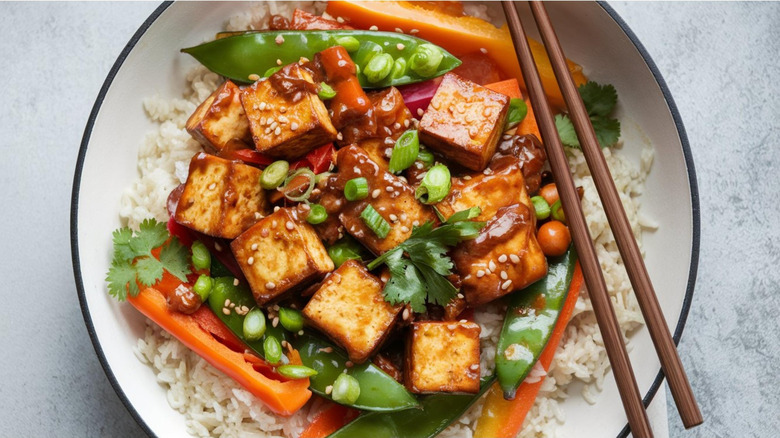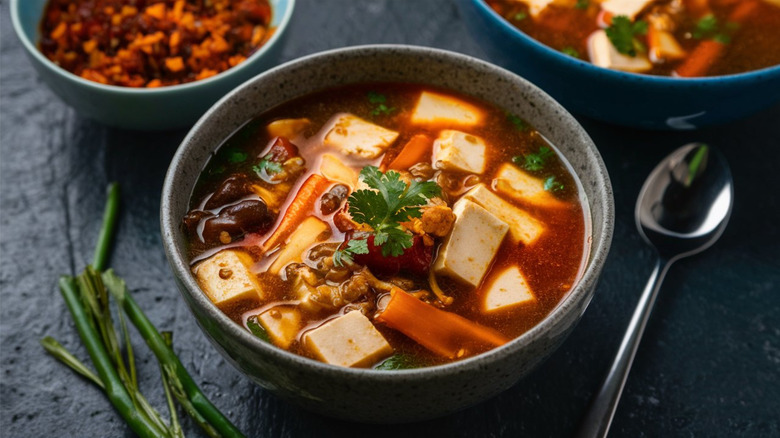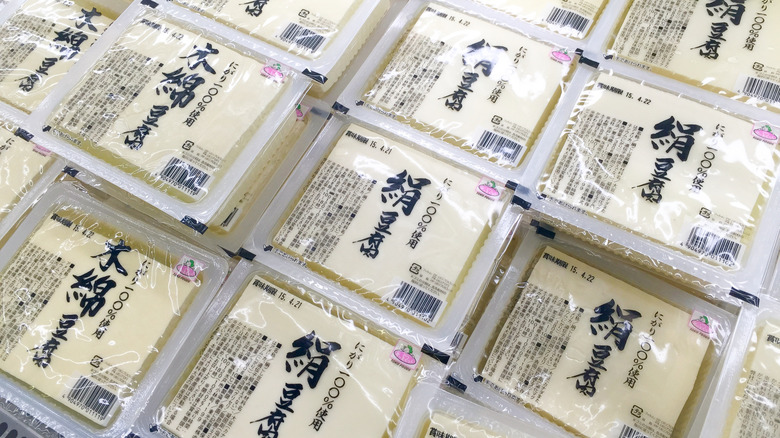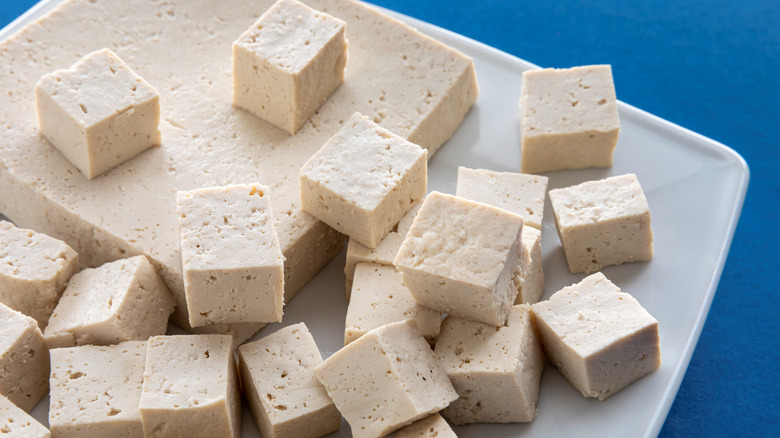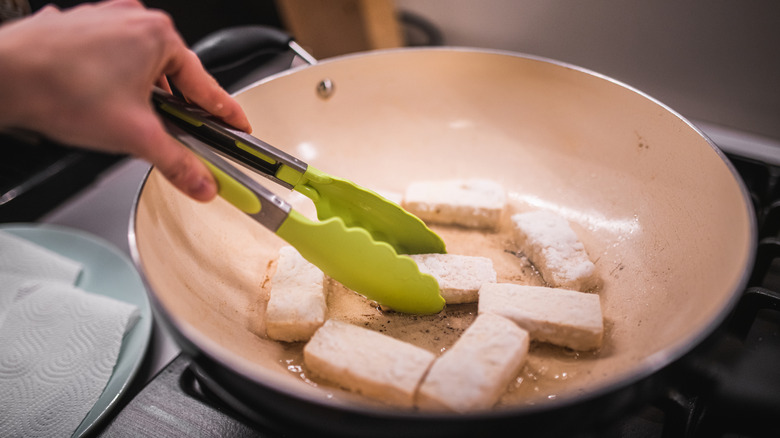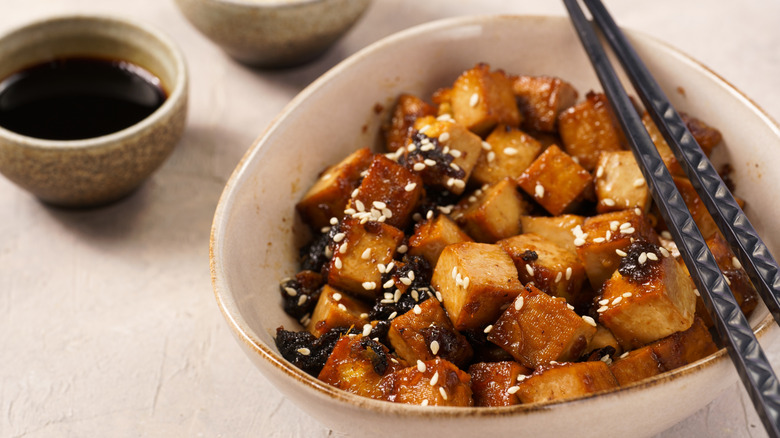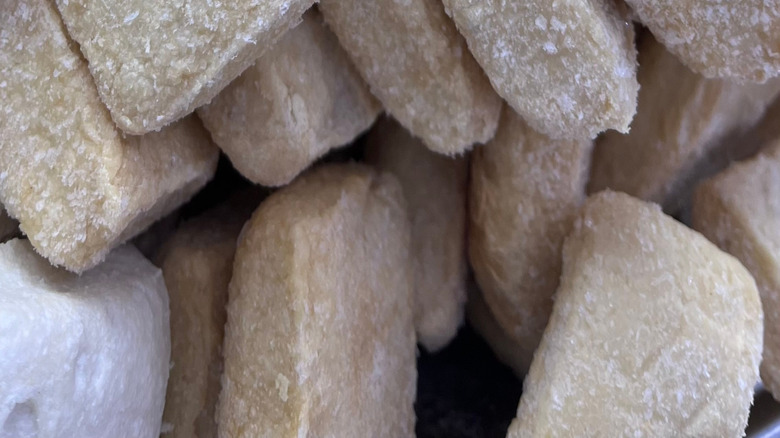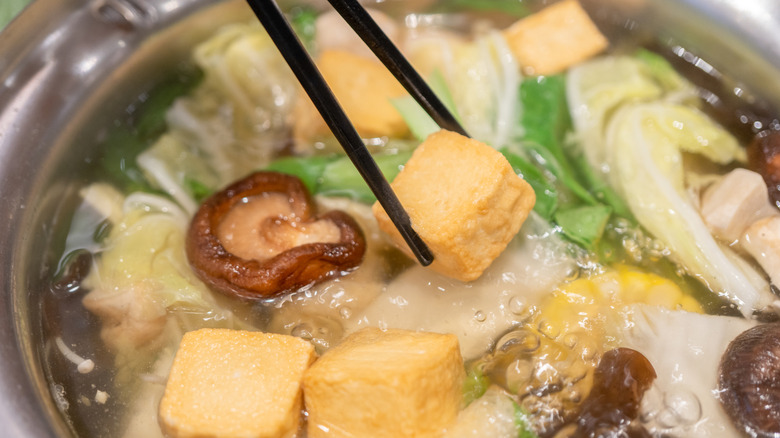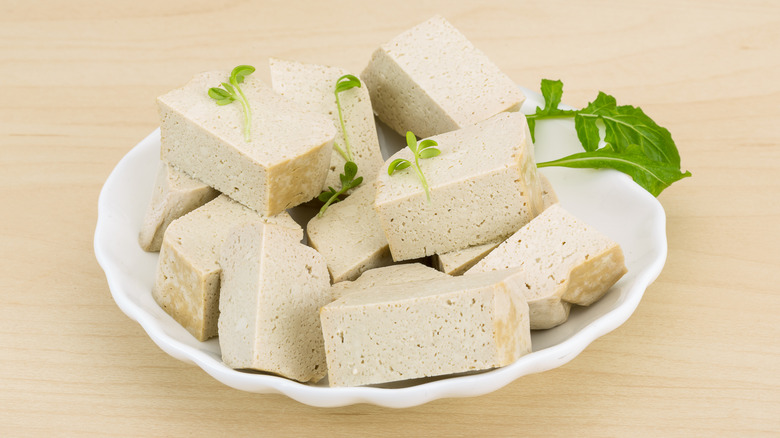The Most Common Mistakes People Make With Tofu
Tofu doesn't have the best reputation for a few reasons. First, it has been plagued with health myths. We'll get this out of the way first: Eating tofu is very unlikely to cause men to grow large breasts. This rumor started because once, in 2008, a male individual drank 12 cups of soy milk every single day, and this may have caused their breast tissue to grow. But let's be honest: Most people do not consume anywhere near this much soy, so the risk is minimal.
Secondly, some believe that tofu is linked with a higher risk of breast cancer. But actually, plenty of research confirms this is not the case and there is not a link between consuming soy-based foods and cancer. In fact, some studies have indicated that there is a chance foods like tofu could even reduce the risk of breast cancer, but more research is needed.
But health isn't the only reason people avoid tofu. Many believe that it is boring and bland with no flavor. And it can be — but only if you're not seasoning it, marinating it, or cooking it correctly, just as you would with most foods. When prepared well, tofu is bursting with potential. It can be added to everything from stir-fries to curries to soups. Tofu is protein-packed, cholesterol-free, and an incredibly versatile addition to your diet. So you know what not to do with this humble soy-based ingredient, here are some of the most common mistakes people make with tofu.
Eating it plain, with no sauce, seasoning, or marinade
Tofu is usually made with just one ingredient: soybeans. To put it simply, they are mashed and boiled to form soy milk, poured into moulds, and left to set in water. The result is tofu. It's a very simple process; sometimes, citric acid is added to the soy milk, but usually there are no extra ingredients like sugar, salt, or flavorings in the mix. This means that, on its own, tofu is incredibly plain, and, as a result, pretty boring to eat.
But tofu's plainness is also its superpower. The soy-based ingredient is mild and absorbent, which means it can take on the flavor of anything you want to pair it with. You can cook it with lemons, black pepper, and garlic powder, for example, to create lemon pepper tofu. If you like spice, you can enjoy it with chili or hot sauce. If you prefer sweet flavors, it also pairs well with honey or agave syrup.
In this sense, tofu is very similar to meat. Chicken, for example, has a very mild taste on its own, but that's why it's rarely eaten plain. Instead, it's paired with sauces like teriyaki, for example, or simmered in a Thai curry. To marinate tofu, simply cover it with your chosen spices, sauces, or herbs (or a combination of all three). Then, pop it in a sealed container in the fridge a few hours before you plan to cook with it.
Not removing the moisture from the tofu
Tofu is usually packaged in water, which helps to keep it fresh. If it's the extra firm variety, there will usually be less water, and if it's the softer type, there will be more water. But one thing is guaranteed: There is always water. Before you start cooking, it's a good idea to at least drain this water out. You can press it, too (which we'll get to shortly).
Removing the water is helpful for a few reasons. Firstly, it means the tofu will soak up your seasoning better, but it also means that it won't get any of your other ingredients soggy when you add it to the pan. To drain, simply cut the packet and then carefully pour out the water into the sink. For some types of tofu, this will be enough, especially if there wasn't much water in the tofu to begin with. But others will need to go further.
One option is to place the tofu in a cheesecloth and twist it hard to squeeze out all of the liquid. You can also pop it in the microwave, which will help to draw out water. Around two minutes should do the trick (but make sure to check on it every 30 seconds).
Note: If you don't use the whole block of tofu, place it back in the fridge and replenish the water in the container every day. This will keep it fresh for longer.
Not pressing it first
If you want your tofu to be really crispy, you need to get as much water out as possible. You can try the microwave trick or the cheesecloth twist, but pressing tofu is also a good idea. There are a few ways to press tofu. Firstly, you can invest in a tofu press, which is a specialized gadget designed to press the water out of tofu. The press usually has two trays, one for the tofu and one for the drips. It also has a lid to push on, which squeezes out the water.
But you don't have to invest in any new products to press tofu — you can also improvise with whatever you have lying around. Place the tofu on a chopping board, wrapped with a paper towel or a tea towel. Then stack it with cookbooks, a frying pan, or anything heavy you have to hand. Make sure your DIY tofu press tower is steady, and leave it for at least 30 minutes. When you come back, much of the water should have drained out from your tofu block.
You don't always need to press tofu. It depends on the type of recipe you want to cook. If you're baking or frying it in chunks, for example, pressing will stop it from going soggy in the pan. But if you're scrambling it like an egg, pressing tofu isn't necessary, as you don't need it to hold its shape and the water will burn off.
Using the wrong type of tofu for the recipe
As mentioned above, not all tofu is equal. There are a few different types, and each works best in different recipes. If you want to make a meaty dish, for example, like tofu nuggets, it's best to opt for a super firm or extra firm tofu. This is because these varieties contain less water and have a denser texture, similar to meat. Soft tofu or silken tofu, however, has a much higher water content and a texture like yogurt, so it will simply fall apart, resulting in a soggy dish that tastes nothing like meat at all.
But silken and soft tofu varieties do have their place in many different recipes. They are ideal for soups or stews, or any liquid-based recipes, for example. They also hold up well in their own right, and can be placed in the center of the plate with other plant-based ingredients, like nuts and pickled chiles, for example.
You can also opt for medium tofu if you want a slightly firmer texture, but you prefer to keep a little softness. Firm tofu is similar to extra-firm tofu, but, as the name suggests, it has a slightly higher water content (which you can press out if needed). Firm tofu can be pan-fried, air-fried, grilled, or baked, depending on your preference.
Cooking it for too long
Like most foods, tofu is at its best when it's cooked for just the right amount of time. After all, nobody wants a charred meal. But cooking the tofu for the correct length of time will also ensure it has the texture you want and that the flavors are spot on, helping you avoid an off putting experience.
If you cook extra firm tofu for too long, for example, it can become tough and rubbery, which isn't the most pleasant of textures (and it's hard to chew, too). It's enough to put you off cooking with tofu for life. Before you start cooking, it's important to brush up on cooking times. Different cooking methods require different amounts of time. If you're baking it, depending on the heat level and your individual oven, around 30 minutes should usually do the trick. But make sure to keep an eye on it to ensure it's not getting too hard, and you should regularly move it and flip it too to make sure it's evenly cooked, too.
Air-fried tofu will usually only take around 15 minutes (sometimes less, so keep an eye on it). After that, it can become too hard and tough. Pan-frying will usually also take about 15 minutes, but you should take it off the heat when it starts to go golden brown in color.
Using oil in the marinade
Oil is very helpful for cooking many different types of foods, from meat to vegetables to plant-based proteins. It can help you sauté perfectly and allow you to create crispy deep-fried textures. It can also help you add nutritional value to dishes; extra virgin olive oil, for example, is rich in monounsaturated fats and polyphenols. Tofu is no exception, and for that reason, many tofu recipes call for cooking oil. But when it comes to the marinade, it's important to put the oil bottle down.
Adding too much oil into the marinade mix may hinder the flavors you're trying to create. This is because oil can actually form a layer around the tofu and block it from effectively absorbing your marinade. That's why it's best to keep your marinade to your key ingredients and save the oil for the cooking part.
However, if you don't want to add any oil to your tofu recipe at all, even during cooking, you don't need to — especially if you're baking it. Simply slather the tofu in your favorite sauces, like soy sauce and maple syrup, before placing it into the oven to bake. You can also air-fry tofu without oil if you want to, although when it comes to air-fryers, it's often best to add a tiny bit of oil to the pan to stop your food from getting too dry.
Only using it to replace meat
Tofu can replace meat in many recipes, especially when it's firm or extra-firm. This is because when fried or baked, it gets a tender texture that is very similar to meat. The taste is spot on, too, especially when it's been marinated in the kind of spices you would cook meat in.
But tofu has plenty of potential beyond just being a meat substitute. It can also take the place of cheese, for example, and is a common ingredient in vegan paneer curries. If you're using really soft or silken tofu, you can also blend it with ingredients like nutritional yeast and lemon juice to make a creamy pasta sauce.
Blended silken tofu, or even blended firm tofu, can also help to thicken up soups and stews, too. They work because they have a very neutral flavor but a thick texture, which means they will enhance the consistency of the dish without impacting the flavor at all.
As mentioned above, tofu (usually either medium, firm, or extra firm) can also be scrambled and served on toast like an egg. Alternatively, it can be mashed with mayonnaise to form the basis of vegan egg salad. The key to a good tofu scramble or egg salad is to add kala namak, which is a Himalayan salt with a sulfurous smell and flavor. When it's combined with fluffy mashed tofu, it tastes just like egg.
Never storing it in the freezer
There are a few ways to store tofu to ensure it is at its best when you next want to use it. Keeping it in the fridge is the most obvious and the most common, but you can also get shelf-stable tofu, which is fine to be kept in the pantry as long as it has not been opened. Silken tofu is often sold in shelf-stable packaging, which is aseptic. This means that the tofu inside is kept away from anything that could contaminate it, including air or light.
However, there is another less common option for tofu storage: the freezer. Keeping tofu frozen helps to reduce its moisture content, which means that when you cook it, it'll crisp up nicely. On top of this, freezing tofu helps to expand its pores (basically water pockets), and this helps the marinade to penetrate deeper into the tofu, resulting in a stronger flavor.
But of course there's also another key benefit to freezing tofu, and that's that it will last a lot longer than in the fridge. When refrigerated, tofu will last a few days, but in the freezer it can last up to three months. So the freezer is not just better for flavor and texture, but it also helps to reduce food waste, too. It's a win win. You should aim to eat leftover tofu after cooking within two to three days. If it starts to look slimy or smell bad, throw it away.
Thinking it can't be boiled
The most popular methods for cooking tofu tend to not involve water. After all, most people want to remove the water from the ingredient, not add it back in. That's why cooking techniques like pan-frying, air-frying, grilling, and baking are often used to cook and prepare tofu. But while it may not be the most popular way to cook tofu, at least in the West, boiling also has benefits, too.
Tofu has been used in Asian countries for centuries. It originated in China before spreading to Japan and Southeast Asia. Today, plenty of Asian recipes are made with tofu, and this means that over the generations, methods of cooking it have been perfected. In Chinese and Chinese-inspired recipes, for example, tofu is often steamed or boiled. It may seem counterproductive, but this method can actually help to remove water from the tofu and give the ingredient a little more structure.
You don't need to boil tofu for long — simply simmer it for around five minutes in salted water (the salt is for flavor) before placing it in a colander to drain. Over time, it will start to firm up. When it's at a good texture, slather it in your favorite marinade, before frying, baking, or enjoying it as-is.
Believing it's too complicated to make it from scratch
Of course, it's easy to stock up on tofu from the store. There are many different varieties on the shelves these days, thanks to the booming tofu market.
If you've got a bit of time on your hands, or you're in the mood to get creative in the kitchen, you can skip the store and make tasty, nutritious tofu from home. To do so, you'll need a few simple ingredients like soybeans, water, and lemons. A tofu mould will also come in handy, as well as a sieve and a spoon for scooping.
There are a number of recipes out there, but we'll give you a basic rundown: You'll need to soak the beans for a minimum of six hours, before blending them in water. After that, drain them through a sieve or cheesecloth to collect the soy milk. That soy milk then needs to be simmered and combined with lemon juice (this works as a coagulant). When it curdles, remove the curds and press into a block. Voilà, you've got homemade tofu.
